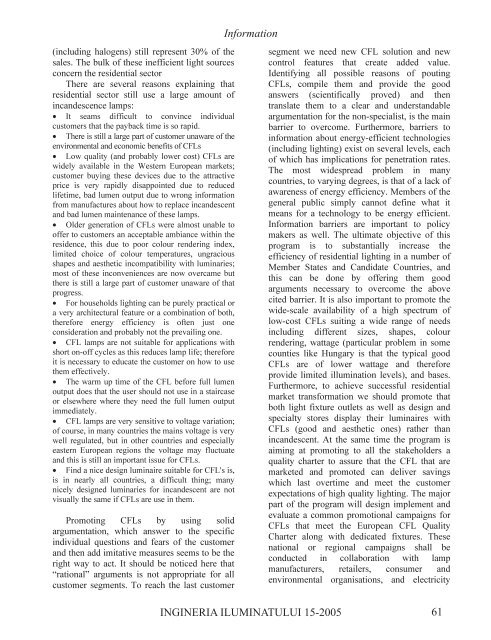Ingineria Iluminatului - Journal of Lighting Engineering - Prof. Florin ...
Ingineria Iluminatului - Journal of Lighting Engineering - Prof. Florin ...
Ingineria Iluminatului - Journal of Lighting Engineering - Prof. Florin ...
You also want an ePaper? Increase the reach of your titles
YUMPU automatically turns print PDFs into web optimized ePapers that Google loves.
(including halogens) still represent 30% <strong>of</strong> the<br />
sales. The bulk <strong>of</strong> these inefficient light sources<br />
concern the residential sector<br />
There are several reasons explaining that<br />
residential sector still use a large amount <strong>of</strong><br />
incandescence lamps:<br />
• It seams difficult to convince individual<br />
customers that the payback time is so rapid.<br />
• There is still a large part <strong>of</strong> customer unaware <strong>of</strong> the<br />
environmental and economic benefits <strong>of</strong> CFLs<br />
• Low quality (and probably lower cost) CFLs are<br />
widely available in the Western European markets;<br />
customer buying these devices due to the attractive<br />
price is very rapidly disappointed due to reduced<br />
lifetime, bad lumen output due to wrong information<br />
from manufactures about how to replace incandescent<br />
and bad lumen maintenance <strong>of</strong> these lamps.<br />
• Older generation <strong>of</strong> CFLs were almost unable to<br />
<strong>of</strong>fer to customers an acceptable ambiance within the<br />
residence, this due to poor colour rendering index,<br />
limited choice <strong>of</strong> colour temperatures, ungracious<br />
shapes and aesthetic incompatibility with luminaries;<br />
most <strong>of</strong> these inconveniences are now overcame but<br />
there is still a large part <strong>of</strong> customer unaware <strong>of</strong> that<br />
progress.<br />
• For households lighting can be purely practical or<br />
a very architectural feature or a combination <strong>of</strong> both,<br />
therefore energy efficiency is <strong>of</strong>ten just one<br />
consideration and probably not the prevailing one.<br />
• CFL lamps are not suitable for applications with<br />
short on-<strong>of</strong>f cycles as this reduces lamp life; therefore<br />
it is necessary to educate the customer on how to use<br />
them effectively.<br />
• The warm up time <strong>of</strong> the CFL before full lumen<br />
output does that the user should not use in a staircase<br />
or elsewhere where they need the full lumen output<br />
immediately.<br />
• CFL lamps are very sensitive to voltage variation;<br />
<strong>of</strong> course, in many countries the mains voltage is very<br />
well regulated, but in other countries and especially<br />
eastern European regions the voltage may fluctuate<br />
and this is still an important issue for CFLs.<br />
• Find a nice design luminaire suitable for CFL's is,<br />
is in nearly all countries, a difficult thing; many<br />
nicely designed luminaries for incandescent are not<br />
visually the same if CFLs are use in them.<br />
Promoting CFLs by using solid<br />
argumentation, which answer to the specific<br />
individual questions and fears <strong>of</strong> the customer<br />
and then add imitative measures seems to be the<br />
right way to act. It should be noticed here that<br />
“rational” arguments is not appropriate for all<br />
customer segments. To reach the last customer<br />
Information<br />
segment we need new CFL solution and new<br />
control features that create added value.<br />
Identifying all possible reasons <strong>of</strong> pouting<br />
CFLs, compile them and provide the good<br />
answers (scientifically proved) and then<br />
translate them to a clear and understandable<br />
argumentation for the non-specialist, is the main<br />
barrier to overcome. Furthermore, barriers to<br />
information about energy-efficient technologies<br />
(including lighting) exist on several levels, each<br />
<strong>of</strong> which has implications for penetration rates.<br />
The most widespread problem in many<br />
countries, to varying degrees, is that <strong>of</strong> a lack <strong>of</strong><br />
awareness <strong>of</strong> energy efficiency. Members <strong>of</strong> the<br />
general public simply cannot define what it<br />
means for a technology to be energy efficient.<br />
Information barriers are important to policy<br />
makers as well. The ultimate objective <strong>of</strong> this<br />
program is to substantially increase the<br />
efficiency <strong>of</strong> residential lighting in a number <strong>of</strong><br />
Member States and Candidate Countries, and<br />
this can be done by <strong>of</strong>fering them good<br />
arguments necessary to overcome the above<br />
cited barrier. It is also important to promote the<br />
wide-scale availability <strong>of</strong> a high spectrum <strong>of</strong><br />
low-cost CFLs suiting a wide range <strong>of</strong> needs<br />
including different sizes, shapes, colour<br />
rendering, wattage (particular problem in some<br />
counties like Hungary is that the typical good<br />
CFLs are <strong>of</strong> lower wattage and therefore<br />
provide limited illumination levels), and bases.<br />
Furthermore, to achieve successful residential<br />
market transformation we should promote that<br />
both light fixture outlets as well as design and<br />
specialty stores display their luminaires with<br />
CFLs (good and aesthetic ones) rather than<br />
incandescent. At the same time the program is<br />
aiming at promoting to all the stakeholders a<br />
quality charter to assure that the CFL that are<br />
marketed and promoted can deliver savings<br />
which last overtime and meet the customer<br />
expectations <strong>of</strong> high quality lighting. The major<br />
part <strong>of</strong> the program will design implement and<br />
evaluate a common promotional campaigns for<br />
CFLs that meet the European CFL Quality<br />
Charter along with dedicated fixtures. These<br />
national or regional campaigns shall be<br />
conducted in collaboration with lamp<br />
manufacturers, retailers, consumer and<br />
environmental organisations, and electricity<br />
INGINERIA ILUMINATULUI 15-2005 61
















